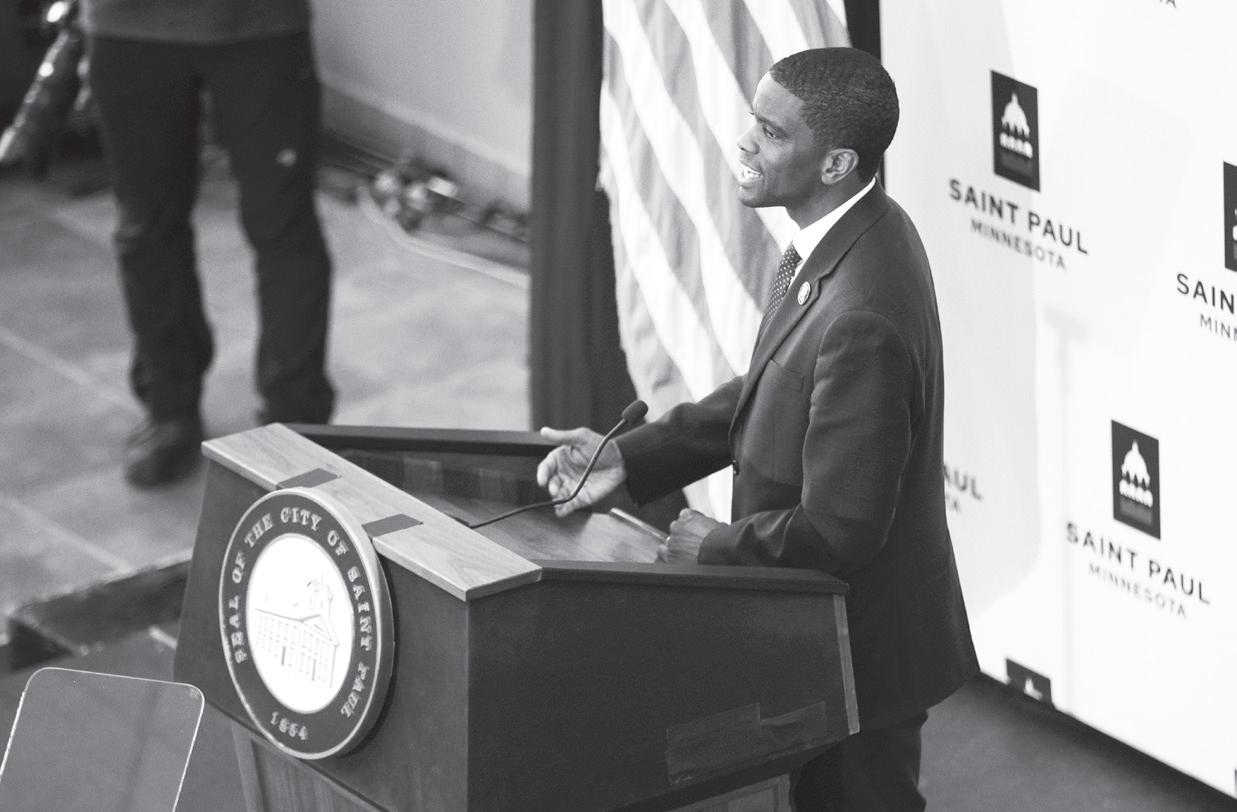
10 minute read
Unlocking the door to homeownership: tips for small business owners
Sponsored Content
While the housing market is finally starting to cool, soaring mortgage rates still have many people feeling like owning a home is out of reach. Small business owners may feel especially behind, as their flexible income and tax situation can make it even more challenging to secure a mortgage.
tential homebuyers with fluctuating income. But with a bit of planning and perseverance, it’s more than possible for small business owners to buy a home.
This guide provides tips and insight on how small business owners can ensure their business remains healthy while smartly navigating the housing market, starting with variable expenses. What are variable expenses, and how can managing them help small business owners
By keeping track of variable expenses and finding ways to cut unnecessary costs, small business owners can free up funds for a home downpayment while determining which expenses are deductible for tax purposes, potentially reducing their overall tax liability.
However, small business owners should remember that write-offs and deductions can unintentionally harm their ability to qualify for a mortgage, so should make those expense reported income and advance on the path to homeownership.
Create healthy boundaries between personal and business finances
Keeping a clear separation between personal and business finances is crucial for small business owners. Not only can it make managing finances easier, but also when it comes time to apply for a mortgage, having all of your financial documents, both personal and business-related, organized and ready to go can streamline the process and potentially improve your chances of getting approved.
“Small business owners must view their unique situation as having two separate entities: As an individual, they are one entity, but as an owner, their small business is the other,” said Stephen Spears, senior vice president of Twin Cities community banking at Bremer Bank. “The
■ See Bremer Bank on page 9
Minnesota’s average 30year fixed mortgage rate is 6.39% — six points higher than the national average. Higher rates can be daunting for potential homebuyers with fluctuating income. But with a bit of planning and perseverance, it’s more than possible for small business owners to buy a home.
This guide provides tips and insight on how small business owners can ensure their business remains healthy while smartly navigating the housing market, starting with variable expenses.
While the housing market is finally starting to cool, soaring mortgage rates still have many people feeling like owning a home is out of reach. Small business owners may feel especially behind, as their flexible income and tax situation can make it even more challenging to secure a mortgage.
Minnesota’s average 30year fixed mortgage rate is 6.39% — six points higher than the national average. Higher rates can be daunting for po- budget for a home?
Variable expenses are costs that fluctuate depending on the needs of a business and can include everything from utilities to marketing expenses.

Variable expenses are divided into two categories: determinations carefully
Determining business write-offs

When it comes to write-offs and deductions, small business owners should weigh the benefits of reducing their taxable income against the potentially negative impact on their mortgage application. Lenders often look at a person’s reported income when determining their eligibility for a home mortgage. Too many expenses may unintentionally lower reported income, making qualifying more challenging.
• Operating costs: Operating costs include utilities, inventory, supplies, marketing and advertising expenses, and maintenance and repairs.
• Costs of Goods Sold (COGS): COGS include raw materials, direct labor, production supplies, and shipping costs directly related to the production and sale of goods.
That said, small business owners should avoid writing off expenses completely! Finding the right balance between reducing taxable income and ensuring mortgage eligibility requirements are being met looks different for everyone.
Achieving homeownership
As a small business owner, it’s important to remember that financial stability and long-term planning are vital to achieving your goals. Here are some actionable tips and tricks to help you manage your business expenses and
C Arter
Continued from page 1 sought elsewhere. But he challenged people to see things differently.
Undoing what’s been done
“I feel like we’ve all inherited what I think of as a broken model in citybuilding that tells us it’s okay to build roads right over people’s houses. It’s okay to just lock up everybody you can find cause that’s how we keep our streets safe. If we want to build the economic future of a city, the way you do that is go find folks outside of our community to spend money on to try to get them to come here,” he said.
In his address, the mayor pointed to the city’s downtown rebound as businesses have begun to return postpandemic. Carter hopes to take his revitalization further and find ways to connect the region’s resources for a more integrated environment for business growth.
“We’re really fortunate to have all the universities that we have and then on top of that all the Fortune 500 company headquarters. They create a really intriguing ecosystem of innovation that happens here,” he said.
During his first year in office, the mayor created the Full Stack initiative to highlight the culture of innovation in St. Paul and the greater metro area. He also hopes to fix the disconnect that communities of color and women experience when it comes to securing seed funding to help their businesses take off.

Business growth is a significant part of the mayor’s plans to incentivize financial growth in St. Paul, and his aims for development are also a part of his vision for the city.
The former site of the Ford assembly plant is now the location of a future development that spans 122 acres of mixed-use commercial and residential units, and repurpose a large portion of the city’s land along the Mississippi.
Naacp
Continued from page 1 media accounts were espousing racist stereotypes, that they were saying negative comments about the NAACP or about certain activities,” continued the professor. “I think by doing that kind of infiltration activity, it undermines the credibility of organizations like the NAACP that are pushing for and making change.”
Zaragoza said the Minneapolis Urban League was also subjected to MPD’s under-
He is also keenly aware of the financial needs of many St. Paul residents.
The Office of Financial Empowerment is the city’s way of getting into the business of helping people figure out how to make their money work for them, as the mayor described it. This comes in the form of helping residents file tax returns, manage college savings accounts for their children, and manage the guaranteed incomes program. It also runs the local fund program which financially empowers individuals to own property.
“It’s a fund intended to help facilitate low-income workers pooling their money and buying the business where they work. It’s lowincome tenants pooling their money and buying their apartment building,” he said. “These are all parts of our strategy to build a more participatory, more inclusive economy here in St. Paul.”
As the Mayor looks to make investments in affordable housing options and business support programs, his State of Our City address also covered his investment in youth.
A son of St. Paul
“My parents had the foresight to just surround us with institutions and adults and places and people who were determined to see us succeed whether we wanted to or not,” he joked.
As the son of a police officer and a schoolteacher, Carter described his childhood as having a certain dichotomy as a Black child growing up in St. Paul. While he saw how certain institutions could hinder his development and opportunities, he also witnessed how they could benefit him.
“That level of interconnectedness that I experienced as a young person growing up in this city was real- any barriers that might affect youth engagement. His office also eliminated late fines in the city’s library system, which led to double-digit increases in library attendance. prevent unsecured guns from “falling into the wrong hands.” Mayor Carter’s father, Melvin Carter Jr., lost his gun in 2019, and after it was recovered it was determined to have been connected to four shootings. The council is set to vote on this ordinance on May 17, with the elder Carter’s story as an example of what can happen without proper storage of firearms.
“It feels to me like we’re really proving this notion that when we bet on people, people pay us a dividend,” he said.
Throughout his time in office, Carter has sought buy-in from the public. This fall he hopes to make that literal in seeking funding to fix the city’s potholes.
In his recent address, the mayor shared that in just the first two months of 2023, the city received 250 claims related to pothole damage to vehicles. Aware of how notorious the potholes have become, the mayor has proposed changes to improve St. Paul roads.
Mayor Carter’s vision of public safety incorporates his Office of Neighborhood Safety, which works to fill in the gaps when emergency response resources aren’t able to connect with individuals.
Continued from page 1 effective strategies to relieve renter cost-burden,” referring to households paying more than 30 percent of their income on housing.
However, the Research Department, a startup supporting investigative journalism unit, issued a memo recently calling the city’s report “a reckless disregard for the truth at best—and deceit at worst.” Logan Carroll, the memo’s author, found that city staffers misrepresented the conclusions of multiple sources. University of Minnesota public policy professor Ed Goetz told Carroll that nearly a quarter of the sources used in the city’s report were “problematic” or “deeply flawed.”
Minneapolis Mayor Jacob Frey, who called affordable cover surveillance along with the NAACP, according to the MDHR report but the Urban League is not part of the NAACP lawsuit.
Not surprisingly, the lawsuit noted that the MPD did not use covert accounts to track the actions of White supremacist or White nationalist groups.
“Looking at surveillance of the Minneapolis NAACP and the Urban League,” she added, “in the lawsuit we pointed out that the (MDHR) report noted no information that MPD was doing the same thing with White supremacist organizations … that actually might be planning dangerous acts.” housing “the top priority in [his] administration,” cited 30 percent area median income (AMI), as his focus for affordable housing production. At a February press conference, Frey said Minneapolis produced six times more affordable housing in 2022, as compared to the average yearly number of units produced between 2011-2018.
Frey says production of affordable units will continue and that Minneapolis has awarded projects to developers for the construction of 2,112 more units of affordable rentals. Of these units, 610, or around 29 percent, will have monthly rental rates affordable for residents making 30 percent of AMI for Minneapolis residential areas.
“Rent stabilization is a critical tool in the toolbox when it comes to guaranteeing St. Paulites can thrive, and has provided an incredible foundation from which to envision safe, stable and affordable housing for all,” MNYC stated in a press ly important to me. It is part of why strengthening that fabric of community is critical to me, ” he said.
Growing up, Carter frequented the Martin Luther King Recreation Center where he would take piano lessons, play basketball, and roller skate with friends among other activities. This experience motivated him to remove the participation fee at the city’s rec centers to allow families to take advantage of the resources and remove
“All my life we’ve been complaining about potholes. We’ve been complaining about the streets and all my life we’ve known that we can do better in St.Paul,” Carter said.
Potholes and public safety
The mayor proposed a one-cent sales tax, that excludes food, clothing, prescription drugs, and rent to pay for the roads. He projected that the city would need to spend a billion dollars over the next 20 years, regardless of the sales tax. Instead of using property taxes on roads and parks, the mayor intends for visitors and workers who travel to the city and enjoy its resources to pay for these changes.
“I think it’s a no-brainer. But again, like I always say, it’s too big a decision for me to just sit in this office and make by myself. That is why the goal is to ask city residents, what do you think,” he added. “We’re asking the legislature permission to do this right now.”
One of Carter’s most difficult challenges is the increasing levels of violence in the city. He pointed to the number of guns now on the street and the need to support victims of gun violence. Carter supported the city council ordinance that would work to
“One of the things we do with our office and neighborhood safety right now is when we have a shooting, as the ambulance races to the hospital and the police race to find the shooter, our office of Neighborhood Safety has folks who race to the hospital to talk to that family, the survivor, and the victim and say, what support resources do you need,” he continued.
In his address, Carter says he also plans to double the recruitment for the police academy and bring on more EMS workers, as the city’s been able to decrease their medical emergency response times by a minute, by creating a more efficient dispatch system to route 911 calls to appropriate personnel and situations.
The city’s Community Alternative Response Emergency Services (CARES) team responds to those in crisis, while those experiencing homelessness are helped by the Unsheltered Response team. While the mayor sees these programs as a success, he hopes to put more resources into preventative measures.
“We put an enormous amount of money into responding to emergencies. And we historically haven’t put that much money into preventing emergencies in the first place, or in reducing or breaking those cycles,” he said. That is something he hopes to remedy.
Abdi Mohamed welcomes reader comments at amohamed@spokesmanrecorder.com.
She observed that if this “is a common tactic or a tactic that MPD used to kind of legitimize in undercover social media accounts, then why aren’t they doing it to White supremacist organizations?”
Zaragoza adds that using social media surveillance, which both MPD and the City assert is legal, is now a part of modern policing and that social media surveillance has become a de facto policy for police departments, even if it’s not something that’s written down.” release celebrating the one-year anniversary of St. Paul’s rent stabilization policy taking effect.
Charles Hallman welcomes reader comments at challman@ spokesman-recorder.com.
“HousingLink data tells us that nearly half of all St. Paul renters live in housing that is not affordable to them,” said Meghan Daly, advocacy manager for MNYC, who wants to see additional rental protections get passed in St. Paul. Daly believes there are several approaches St. Paul can take to increase affordability, such as capping the maximum cost of security deposits and increasing the stock of housing available to people making 30 percent or lower than the area median income (AMI).
The City Council may consider a rent stabilization policy through the legislative process. If passed, a rent stabilization ordinance would be added to the ballot for approval by Minneapolis voters.
Cole Miska welcomes reader comments at cmiska@spokesman-recorder.com.









